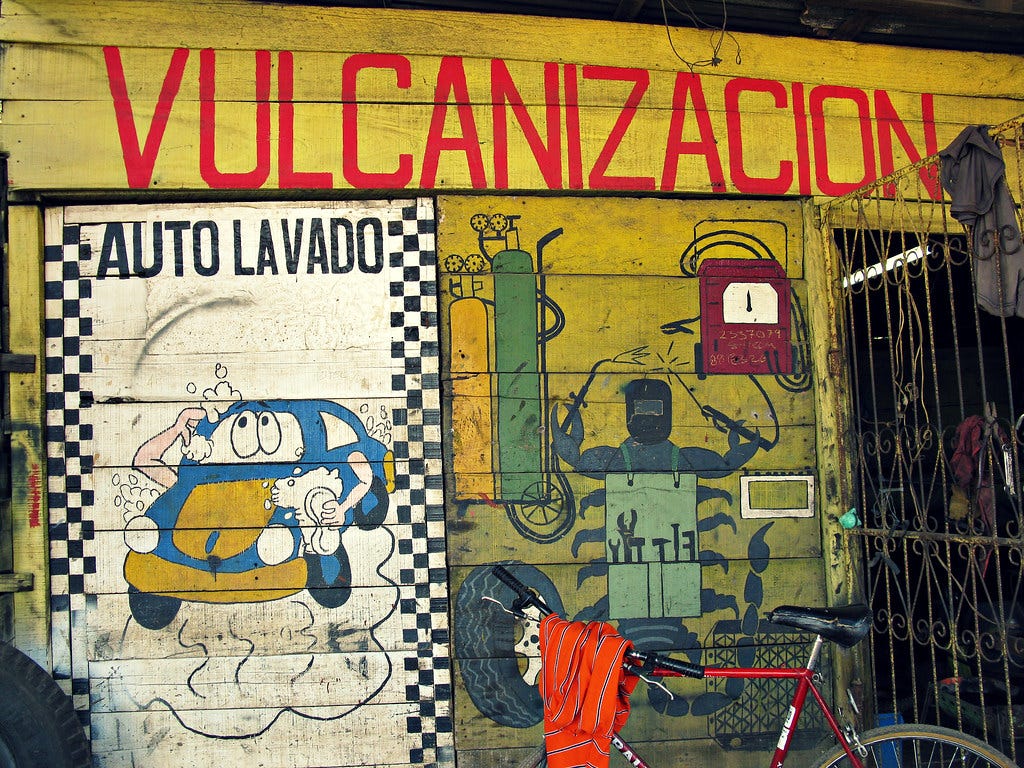
Italy’s Mount Etna, a famous volcano situated in Sicily, is in the news today because it has been shooting a large amount of ash and lava into the air. Perhaps it’s no wonder that the Romans, who lived in that part of the world, created a god of fire and made his home under a volcano.
His name was Vulcan, also written as Volcanus, and from that name came the Italian word for volcano.
volcano — I doubt I need to define this, but the dictionary definition is this: a vent in the crust of the earth or another planet or a moon from which usually molten or hot rock and steam issue.
vulcano — the Italian cognate
volcán — the Spanish cognate
English borrowed the word directly from Spanish and Italian around about the year 1665.
I distinctly remember one day many years ago when I was in Mexico seeing my friend and we were driving down the road in Merida, and I saw a sign similar to the one pictured below:
At the time, I had no idea that I was looking at a cognate, “vulcanization.” I simply had never heard of the word and knew nothing about it. I asked my friend what “vulcanizaciόn” meant, and she looked at me like I was an idiot. While she didn’t know exactly what the process was either, she knew it had to do tires and that all the tire places had that word on them. Sure enough, once I’d seen one, I began to see the “vulcanizaciόn” signs at every tire place throughout the city and in other towns we visited as well.
The definition for “vulcanization” is this: the process of chemically treating a natural or synthetic polymer and especially rubber to give it useful properties (such as elasticity, strength, and stability) — things you want your tires to have!
I’m sure you’ve already realized that this word comes from the Roman god of fire, Vulcan, and not something from Spock’s homeland. As merriam-webster.com explains, “vulcanization in its simplest form consists of heating rubber with sulfur in order to improve the rubber's qualities. The Roman god Vulcan (whose Greek counterpart is Hephaestus) was the god of fire and of skills that used fire, such as metalworking. So when Charles Goodyear discovered that high heat would result in stronger rubber, he called the process "vulcanization" after the god of fire. Goodyear developed the idea in 1839 and acquired a patent for it in 1844.”
We have a verb which is “to vulcanize” that is “vulcanizar” in Spanish.

The science that deals with the study of volcanoes is called both “volcanology” and “vulcanology,” and the scientists can be called “volcanologists” or “vulcanologists.” In Spanish, that science is “vulcanología” and in Italian, it is the same, but without the written accent mark. In Spanish, the scientist is a “vulcanόlogo” for a male and “vulcanόloga” for a female, and in Italian, they are the same, also, minus the written accent marks. (My own word for someone who chooses to study volcanoes up close and personal would probably be something else!)
The adjective, “volcanic,” becomes “volcánico” to describe masculine things in Spanish and “volcánica” to describe feminine things. The Italian cognate retains the letter “u” and is “vulcanico” and “vulcanica.”
“A volcanic eruption” becomes “una erupciόn volcánica” in Spanish and “un'eruzione vulcanica” in Italian. You can see that “eruption” is also a cognate, but we’ll cover that word another time.
This is the free post for June. If you’re a paying subscriber, you have access to the recorded version as well, which is available on Spotify, too. Upgrade to paid status to have full access to the archive of more than 200 entries also and to receive these posts weekly instead of monthly. It’s only a few dollars a month. Thank you.
Tammy Marshall













